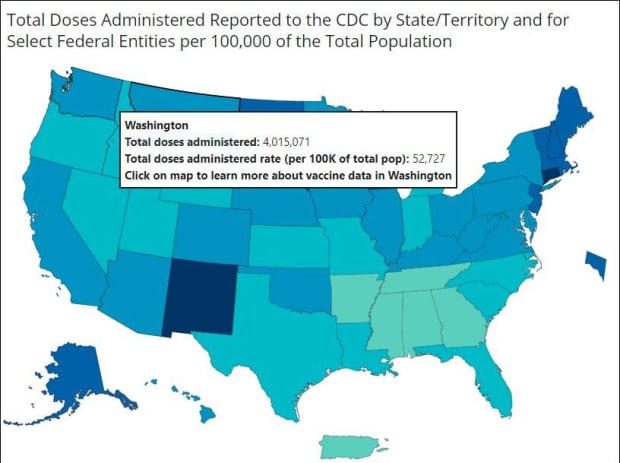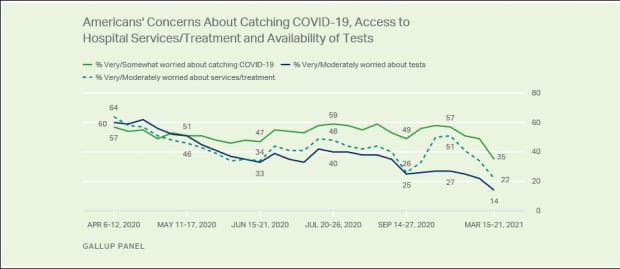This post was originally published on this site
The U.S. COVID-19 vaccine push got another boost Tuesday, with President Joe Biden expected to announce that all Americans will be eligible for a jab by April 19, moving up an earlier deadline of May 1.
Biden had previously pledged to have 90% of the U.S. population eligible by April 19, but increased supply of the vaccines that have been authorized for emergency use has helped the federal government get more doses out more quickly.
The Centers for Disease Control and Prevention’s vaccine tracker is showing that as of 6 a.m. ET Monday, 207.9 million doses had been delivered to states, 167.2 million doses had been administered and 107.5 million people had received at least one of a two-dose regimen, equal to 32.4% of the population.
In all, 62.4 million people are fully vaccinated, meaning they have received two shots of the two-dose vaccines developed by Pfizer Inc.
PFE,
and German partner BioNTech SE
BNTX,
and Moderna Inc.
MRNA,
or one of Johnson & Johnson’s
JNJ,
one-shot vaccine. That’s equal to 18.8% of the population.
In the 65 years-and-older group, 30 million people are fully vaccinated, more than half—54.9%—of that population. In some states, that number is even higher.

CDC vaccine tracker
Still, cases are rising and experts are increasingly concerned. The U.S. added at least 76,594 new cases on Monday, according to a New York Times tracker, and at least 530 people died. The U.S. has averaged 64,581 cases a day for the last week, up 20% from the average two weeks ago.
Experts are concerned that the seven-day average remains higher than the 14-day average, which they blame on pandemic fatigue after a year of restrictions on movement, and as some states drop face-mask mandates. The White House COVID Task Force and other health experts have repeatedly called on Americans to stick with public-safety measures, namely frequent hand washing, social distancing and wearing a face mask in public — even after being fully vaccinated.
A Gallup poll published Tuesday found that Americans’ concerns about getting the virus have fallen to a record low. Just 35% of adults say they are very or somewhat worried about contracting COVID, the lowest since April 2020, and down from 49% in the last survey.

Source: Gallup poll
Andy Slavitt, a White House senior adviser for the nation’s COVID-19 response, told reporters at a Monday White House press briefing that the U.S. is headed in the right direction.
“But as you heard the president say: We’re not there yet. The war against COVID-19 is far from over, far from won. The worst thing we could do right now would be to mistake progress for victory. If we let our guard down now, we will see more of our fellow Americans get sick and die unnecessarily. “
CDC Director Dr. Rochelle Walensky agreed, and noted that most of the rising cases nationally involve younger adults, who are being infected with new, more transmissible variants, as they start doing sports and other extracurricular activities again.
“I understand that people are tired and that they are ready for this pandemic to be over, as am I,” she said. “Please continue to hang in there and to continue to do the things that we know prevent the spread of the virus.”
In other news:
• Catalent Inc.
CTLT,
a contract drug manufacturer, is expanding U.S. production of the COVID-19 vaccine developed by Moderna and will nearly double production at its Bloomington, Ind. plant to about 400 vials a minute in April, the companies said, confirming a Wall Street Journal report. The plant will be able to make an additional 80 million vials a year and will start shipping new doses in May, the people said. The move will help Moderna reach its target of delivering an additional 100 million doses to the U.S. government by the end of May and another 100 million by the end of July.
• Dynavax Technologies Corp.
DVAX,
said Tuesday that French vaccine maker Valneva plans to commence a Phase 3 trial of its inactivated COVID-19 vaccine candidate, VLA2001, with Dynavax’s CpG 1018(TM) adjuvant by the end of April after achieving positive results in a Phase 1/2 trial. The trial involved 153 healthy adults aged 18 to 55 years old and found the combination was safe and highly immunogenic. The group giving the highest dose produced antibodies and T cells and only showed mild to moderate adverse events. “We believe the effect delivered by our CpG 1018 adjuvant combined with Valneva’s existing manufacturing process for whole virus inactivated vaccines will result in an important option in the global fight against COVID-19,” Dynavax Chief Executive Ryan Spencer said in a statement.
• Australian and New Zealand residents will be able to travel between the two nations without having to quarantine from April 19, the BBC reported. Since October, New Zealand travelers have been allowed to enter most Australian states without quarantine, though this had not been reciprocated. Both nations have since contained COVID outbreaks and kept infection rates near zero. The countries shut their borders in March last year and brought in compulsory quarantine for returning nationals.
See also: Vaccines are here. That’s no reason to call off the hunt for effective COVID-19 treatments.
• North Korea will not be attending the coming Tokyo Olympics out of worry its athletes could contract COVID, CNN reported. North Korea decided to sever almost all of its ties with the outside world in 2020 to prevent an influx of coronavirus cases. The country has not reported a major outbreak of the deadly illness, and there have been no indications one has taken place, though experts doubt Pyongyang’s claim the country has not seen a single case of the virus. Foreign diplomats and aid workers have also fled the country en masse in recent months, citing shortages of goods and extreme restrictions on daily life, according to the Russian Embassy in Pyongyang.
• Europe’s drug regulator, the European Medicines Agency, denied Tuesday that it has found a clear link between the AstraZeneca PLC
AZN,
AZN,
vaccine developed with Oxford University and a blood clotting syndrome, after a senior official said there was a link, the Guardian reported. The EMA said the review is ongoing and that it expected to announce findings later this week. A number of countries halted use of the AstraZeneca vaccine in recent weeks over the blood clotting events in a small number of patients. France, Germany, Italy, France, Spain, the Netherlands and Canada have suspended its administration in people aged under 55, 60 or 65.
See now: CDC offers travel advice to vaccinated Americans—but stops short of saying it’s OK to get on a plane
Latest tallies
the global tally for the coronavirus-borne illness rose above 131.8 million on Tuesday, according to data aggregated by Johns Hopkins University, while the death toll rose above 2.86 million.
Almost 75 million people have recovered from COVID, the data show.
The U.S. continues to lead the world by cases, at 30.8 million, or about a quarter of the global tally, and fatalities, at 555,619.
Brazil is second globally in cases at 13 million and also second with a death toll at 332,752.
India is third worldwide in cases with 12.7 million and fourth in deaths at 165,547.
Mexico is third by deaths at 204,399 and 14th highest by cases at 2.3 million.
The U.K. has 4.4 million cases and 127,106 deaths, the highest in Europe and fifth highest in the world.
China, where the virus was first discovered late last year, has had 101,908 confirmed cases and 4,841 deaths, according to its official numbers.
What’s the economy saying?
Job openings in the U.S. rose in February to the highest level in more than two years as the economy emerged from a winter torpor tied to a record increase in coronavirus cases, MarketWatch’s Jeffry Bartash reported.
The number of job openings jumped to 7.37 million from 7.1 million in January, the Labor Department said Tuesday.
The economy began to accelerate early in the new year after a sharp decline in coronavirus cases. Rising vaccinations, relaxed government business restrictions and another massive dose of federal stimulus have all helped to goose the economy, with faster growth expected in the months ahead.
Last Friday, the government said the U.S. gained 916,000 new jobs in March in another clear sign the economy is strengthening.
The International Monetary Fund on Tuesday raised its global economic outlook, citing a much brighter picture for the U.S. economy, MarketWatch’s Greg Robb reported.
The IMF raised its U.S. outlook sharply in 2021 to 6.4% this year from 5.1%. The U.S. should see solid 4.4% growth in 2022.
The Fed sees the U.S. economy growing at a 6.5% pace this year but with a steeper slowdown to a 3.3% growth rate in 2022.
The IMF raised its estimate for global growth to 6% this year and 4.4% next year. This represents an upgrade of 0.5% for 2021 and 0.2% for 2022 from what it forecast in January.
Gita Gopinath, the IMF’s economic counsellor, said “a way out of this health and economic crisis is increasingly visible.”
Losses over the medium term from the pandemic are likely to be smaller than in the aftermath of the financial crisis. But this time, low-income countries and emerging markets will suffer more compared with the fallout from the Great Recession.
The Dow Jones Industrial Average
DJIA,
and the S&P 500
SPX,
were flat Tuesday.
Read also:The dangers of uneven global growth, and how to avoid that trap

